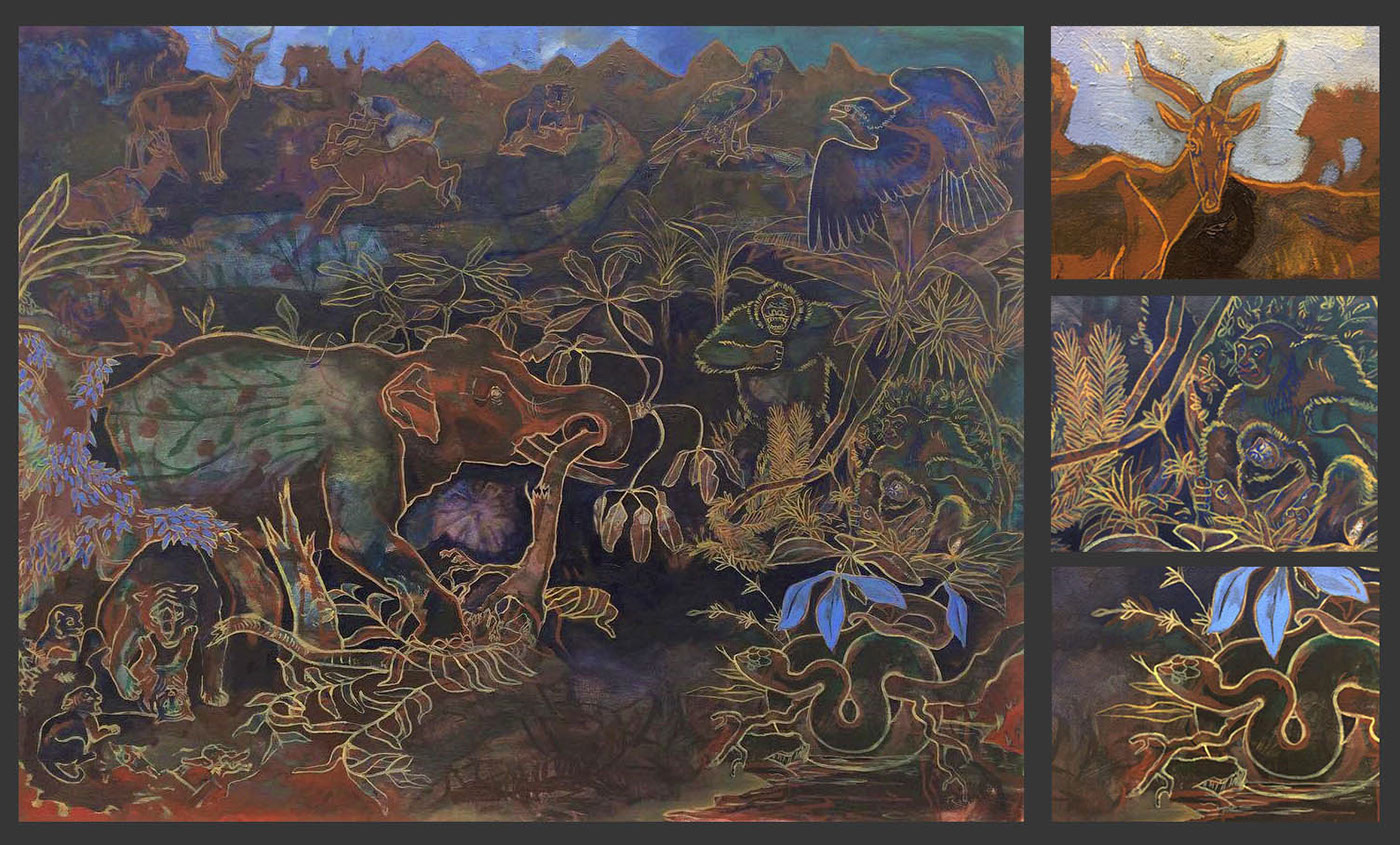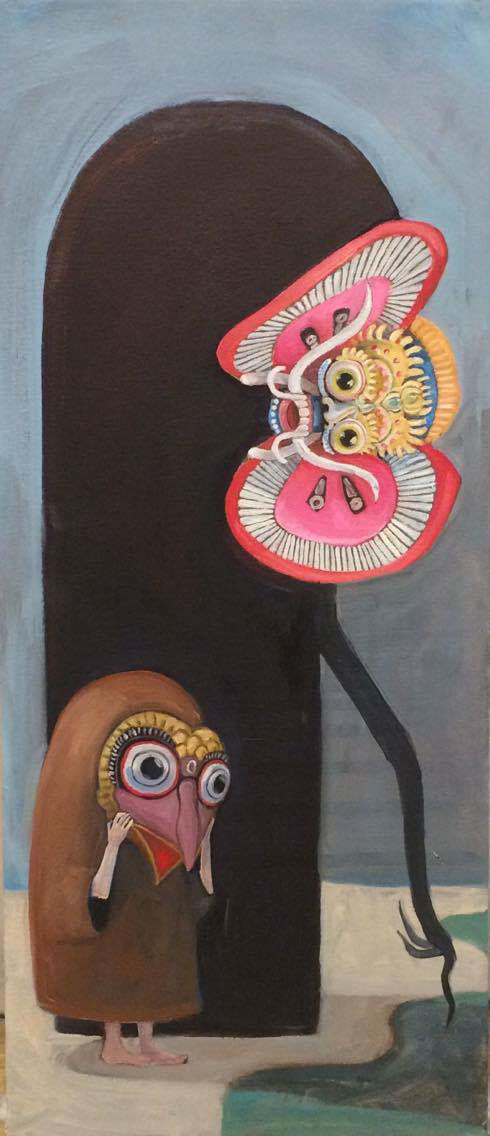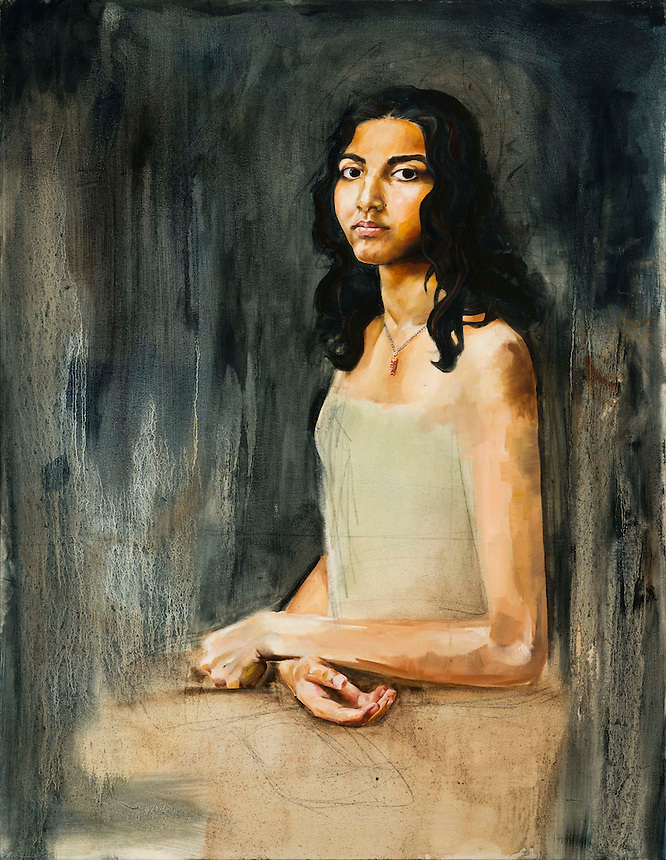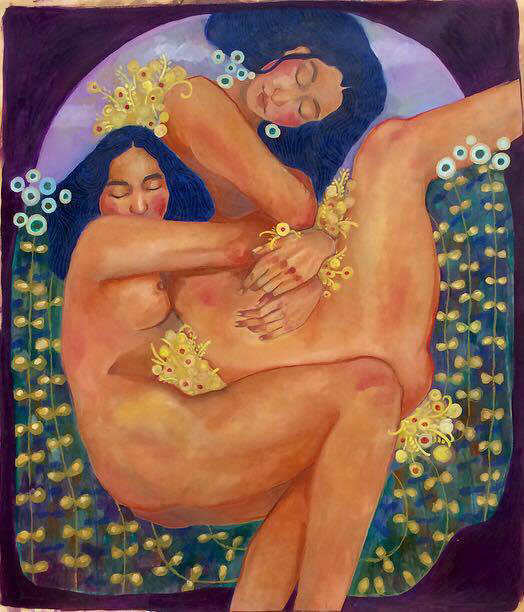A Conversation with Anjali Shankar
By Olivia LaRosa
Anjali Shankar is a junior at the Maryland Institute College of Art and Design studying Painting. We discuss international influences in art, film, and nightmares.
What are the things that most influence your art? I mean other artists, concepts, music, experiences, stuff like that.
More recently I’ve been especially interested in color and color theory. I love interactions between color. Josef Albers’ book [The Interaction of Color (1963)] has definitely influenced my recent work. I’m actually taking a color theory class right now, and I’m finding it so interesting how we perceive color and the contexts in which that perception can change.
For music, I’d say Kali Uchis, Childish Gambino’s album “Awaken,” Kaytranada, and Frank Ocean.
And why these artists in particular?
Well, musically the layers of sounds and combinations of sounds interest me, and I’ve noticed that these artists tend to use layers in really dynamic ways. In my work, I’m interested in how visual things are layered. Like in my sketchbook I draw over things, and I write over things to the point where you can’t always recognize what was originally there.
I think Van Gogh has also been a big influence on me because when I was younger and I first saw his paintings-- just, I don’t know, the thickness of the paint, the movement, and the color I was like “woah!” I definitely play with paint thickness in my own work.
Are there any contemporary visual artists you acknowledge as influences?
To be honest, I think I might be most influenced by the other students around me! Many of my friends who do illustration, I just love how they create really strong narratives [with their characters].
The first time I saw [a friend’s work] it clicked for me that suggesting a mark or a figure can be a lot more interesting than articulating the whole object. That was really a pivotal moment for me.
What about film? I know you love movies, so would you say you they affect your art at all?
Oh, I’m influenced a lot by film! Like how one shot in context relates to others, like…remember in high school [our film studies teacher], would talk about that technique with shots…?
Like Kuleshov*?
Yes, exactly! I love thinking about the Kuleshov effect in terms of painting and how images feed off one another, and you gain context from an image’s placement amongst other images.
Any filmmakers in particular that resonate with you?
I’d say [Quentin] Tarantino and Hayao Miyazaki films.
What is it about their films that inspire you?
For Miyazaki, Princess Mononoke [1997], specifically because conceptually it’s very complex and there are a lot of layers to the story, a lot of the scenes are very dense. I love the war scene and there’s drum music that goes along with the shots. It’s so cool! Satoki Kon films too. Perfect Blue [1997] is one of the first ones I saw by him. I love his compositions, and he uses a lot of reflective surfaces which I use in my art too. They’re all very dreamlike which I love.
How has the focus on your art shifted throughout the years?
I’ve always been interested in strong, powerful women. A lot of my work focuses on women and sexual violence. A few years ago I was working really figuratively, but over time my figures have gotten simpler. Now it’s definitely more illustrative and less detailed.
This past year I’ve done lots of pieces relating to familial relationships, memories, that sort of thing. I guess I was going through a nostalgic phase. When I was in Italy this past spring I was going through a lot of frustration, so my work was kind of a lot of angry dogs, people fighting, and a lot of blood. I guess that sort of went back to when I did a lot of sad art in high school.
Well yeah let’s actually go back a little bit because I know you definitely had a very international upbringing, I guess you could say. I’d like to talk a little bit about that because your art seems, to myself at least, to tell a very global story.
For sure; I was born in Baltimore, but I grew up overseas and travelled a lot. My mom is from College Park, Maryland, and my dad’s from Athens, Ohio. When I was 2 my family moved to Jakarta, Indonesia, and we were there for about seven years, and that’s where I consider having most of my childhood.
And how do you remember that time?
I loved it! I was interacting with a lot of different people around the house. Because the US dollar went really far there, we had a driver and gardeners and maids. Both of my parents were working in public health. They’re just such interesting people! My dad did the Peace Corps as a medical anthropologist in Nigeria, and my mom conducted public health research in Nepal. When they got married, they went to India to adopt my two older sisters, and then they went to Papua New Guinea for two years, then came back to America.
I would travel a lot with my mom growing up, including Bolivia, Germany, and many different parts of the USA. And that travel has influenced my work in the different cultural elements I include.
After Indonesia, we moved to France and it was a complete 180; it forced me to become really independent, because I moved around to so many different schools there. I ended up just spending a lot of time with my younger brother. None of us really adjusted very well socially, but the surroundings of course were really beautiful! We were really isolated in the countryside; it was a little place called Divonne-Les-Bains right on the border of Switzerland.
When and how did your love of art come about?
I always remember loving drawing. I would draw on my arms a lot as a kid. My grandma also used to paint, and I also felt like she was an idol of mine because she wasn’t allowed to do a lot of things as a woman in India, but she would do them anyways. She was a really strong woman! I would paint with her and I was always very much encouraged to keep making things. My dad also always seemed very interested in my drawings when I was little. Like on the flight from Indonesia to France, he looked over and saw these little lizards and dragons I was drawing and turned to my mom and was like “Anita, we’ve gotta foster this!”
When did the possibility of becoming an artist professionally really click for you?
Not until junior year of high school. Pre-college [painting program at MICA] was a turning point because I got a lot of recognition and encouragement from my teachers. My parents were very supportive of me going to art school too, so having their support really helped me a lot.
When did you finally move to Massachusetts, and what was the biggest culture shock?
I moved to Massachusetts in middle school, and the biggest culture shock was the realization that the big yellow school buses were real! I thought they were just, like, in American movies.
So you mentioned that travelling and moving around as a kid inspired you in your art because you were experiencing all these different cultures. Is there one place in particular that has completely changed your approach to art?
Well Italy was when I started writing again, and so I’ve been incorporating more of that into my work. I used to write in high school, you know like record dreams and nightmares. I wasn’t having nightmares in Italy, but I would write down some dreams and letters and thoughts about people.
What was your final exhibition for that semester abroad?
We all had a gallery showing and I had three walls dedicated to my work where I left some of those writings as well as my sketchbook on display to go along with my paintings. The paintings were all related to one another because they all dealt with texture and surrealism.
What is the most recent piece you’ve worked on?
Right now I’ve been focusing on drawing paper and playing with different planes of light. Also mark making which is just using lines and marks to make a piece.
What do you feel like you would be doing right now were it not art? What’s, like, your secret second calling?
In a parallel universe I would be an ecologist! I just love biology and I like how things are connected to one another. I love the deep ocean so maybe a marine biologist or ecologist. Oh, but I’d also want to be a filmmaker… I don’t know!
Like Jacques Cousteau!
Yeah, sure!
__________________
You can see more of Anjali’s work on her Instagram, @or_anj_juice.
All images courtesy of the artist.
* Kuleshov effect: The phenomenon in film by which audiences attach specific meanings and emotions to seemingly unrelated images depending on how they are assembled.







